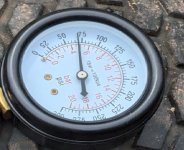Okay Mark I see what you mean. Yeah this is a mower deck.What I said works fine for a single engine mower. With a PTO involved, you're over my head. If you're getting a compression tester, that's the best test, I'd wait on that.
You are using an out of date browser. It may not display this or other websites correctly.
You should upgrade or use an alternative browser.
You should upgrade or use an alternative browser.
Briggs& Stratton engine will not turn over
- Thread starter JimP2014
- Start date
More options
Export threadYes Mark it is a single cylinder engine but one thing that I did find when looking at various videos and I think for just Briggs& Stratton engines is that with the valve cover off? If you look at the rocker arm where it makes contact, basically with a tap pet and the valve spring. In other words, on that side, what happens or what's supposed to happen is that as that rocker arm moves away from the engine not towards it, but away from it. There's a little area at the very top of that motion. Someone referred to it as a bump but what happens is almost at the top. It retracts back in towards the engine slightly and then goes back up and the reason I mention it is I see that motion with the intake valve which is on the bottom for this Briggs& Stratton but the exhaust valve. It doesn't have that little bump where the motion is generally out, but for a split second it goes back only to continue out. I'm not sure if this makes sense to anyone but the exhaust valve which is on top does not have that motion.Single cylinder engine.
Jim
dougand3
Well-Known Member
- Joined
- Mar 10, 2012
- Threads
- 13
- Messages
- 461
I think you're describing compression release. On most LT/GT and bigger engines, the camshaft has an arm that bumps the valve at low RPMs. This allows the crankshaft to spin faster & start/run. Cam arm slings out of the way at higher RPMs for full compression.
Ironically I just watched that video again and it seems like the fellow is only paying attention to the intake valve and then he concluded because of that bump that the camshaft is okay and then he was able to put it back together and get it goingI think you're describing compression release. On most LT/GT and bigger engines, the camshaft has an arm that bumps the valve at low RPMs. This allows the crankshaft to spin faster & start/run. Cam arm slings out of the way at higher RPMs for full compression.
Ironically I just watched that video again and it seems like the fellow is only paying attention to the intake valve and then he concluded because of that bump that the camshaft is okay and then he was able to put it back together and get it going
I was hoping to upload an image of the compression tester gauge but the image is too large anyways, so it's a cold engine. I opened up the throttle choke and all that to get a lot of air in. I then came up with 75 lb PSI and I tried a few more times and it did not get any higher. I did not add oil into the spark plug hole. I'm wondering if 75 PSI for a 19 and 1/2 horsepower OHV engine. It's an intek engine is what it should be. Maybe it should be 110 PSI. This I don't know so I wonder what any thinks about this?
Thanks,
Jim
Thanks,
Jim
I just happen to watch a video of an 18.5 horsepower OHV engine model 31 and the guys getting 125 psi. I can only say it seemed like none of the four adapters in the kit fit correctly into the spark plug hole. So I just ran the hose with the fitting and the gauge on the other end. I'm not sure if I lost any compression in the test but to say it in a different way. There was probably eight pieces inside the compression kit and I used only two of them and came up with 75 PSI.
Jim
Jim
So I use the compression tester one more time. I found out that none of those adapters fit into the spark plug hole but they supplied basically a pipe with like a cone-shaped rubber boot on the end and I use that and as it turns out I got up to about 85 psi. I most likely bought junk where it doesn't have a adapter that fits inside a spark plug holeI just happen to watch a video of an 18.5 horsepower OHV engine model 31 and the guys getting 125 psi. I can only say it seemed like none of the four adapters in the kit fit correctly into the spark plug hole. So I just ran the hose with the fitting and the gauge on the other end. I'm not sure if I lost any compression in the test but to say it in a different way. There was probably eight pieces inside the compression kit and I used only two of them and came up with 75 PSI.
Jim

